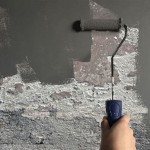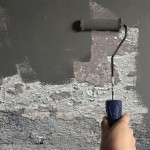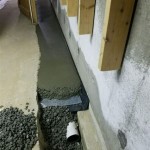How To Paint Old Concrete Basement Walls
Painting old concrete basement walls can significantly improve the appearance and functionality of your basement space. Whether you're looking to create a finished living area, a workshop, or a storage space, a fresh coat of paint can make a world of difference. While the process is relatively straightforward, preparing the walls properly is key to achieving a long-lasting and attractive finish. This guide will provide you with step-by-step instructions for painting old concrete basement walls, ensuring a successful and aesthetically pleasing outcome.
1. Prepare the Walls
The first step is to thoroughly prepare the walls for painting. This involves cleaning, repairing any damage, and applying a primer.
Cleaning: Begin by cleaning the walls to remove dirt, dust, cobwebs, and any loose paint or debris. A stiff-bristled brush or a shop-vac with a brush attachment can be effectively used for this purpose. For particularly stubborn stains, a mild detergent solution can be applied, followed by a thorough rinsing with clean water. Allow the walls to dry completely before proceeding.
Repairing: Any cracks, holes, or uneven surfaces should be repaired before painting. For minor cracks and holes, use a patching compound or spackling paste. Larger cracks may require using a concrete patching material. Apply the patching material according to the manufacturer's instructions, smooth it out, and allow it to dry completely before sanding it down for a smooth finish.
Priming: Apply a primer specifically designed for concrete surfaces. A primer provides a good bonding surface for the paint and helps prevent the paint from peeling or cracking. Apply the primer evenly using a roller or brush, allowing it to dry completely before applying the paint.
2. Choose the Right Paint
Selecting the appropriate paint is crucial for a successful project. Consider the following factors when choosing paint for your basement walls:
Type: Choose a paint specifically formulated for concrete surfaces. This type of paint is designed to adhere to the porous nature of concrete and prevent moisture from seeping through. Consider using a water-based acrylic paint, as it is easier to clean up than oil-based paints.
Color: Lighter colors tend to reflect light and make the basement feel larger and brighter. However, if you prefer a bolder look, you can opt for darker colors. If you are concerned about humidity, consider using a mildewcide-resistant paint.
Finish: Select a finish that suits your needs. A flat finish hides imperfections but is more susceptible to stains. A satin finish is slightly more durable and easier to clean. A semi-gloss finish is the most durable and washable but may highlight imperfections.
Quantity: To determine the amount of paint needed, measure the area of the walls to be painted. A good rule of thumb is to apply two coats of paint, so purchase enough for both applications.
3. Paint the Walls
Once the preparation is complete, you're ready to start painting. Follow these steps for a professional finish:
Start at the Top: Begin painting at the top of the walls to prevent drips from falling onto areas already painted. Use a brush for the corners, edges, and trim, and a roller for the larger surfaces.
Use Long, Even Strokes: Apply the paint in long, even strokes to ensure uniform coverage. Overlapping each stroke by an inch or two will help prevent streaks and brush marks.
Apply Two Coats: Apply a second coat of paint after the first coat has dried completely. This will provide a more even finish and enhance the durability of the paint.
Clean Up: Clean your brushes and rollers immediately after painting with soap and water or a paint thinner, depending on the type of paint you used.
Remember to keep your workspace well-ventilated when painting and to wear appropriate safety gear, including gloves, protective eyewear, and a respirator.
Painting old concrete basement walls can be a rewarding project. By following these steps, you can transform your basement into a comfortable, functional, and visually appealing space. From creating a cozy home office to setting up a playroom for the kids, the possibilities are endless. Consider the style and function you desire for your basement, and let the paint bring your vision to life.

Basement Finishing Do Not Paint Your Walls

Painting Cinder Block Walls In A Basement Or Re Paint Them

6 Best Paints For Concrete Basement Walls

Reasons To Avoid Painting Your Basement Walls

Painting Cinder Block Walls In A Basement Or Re Paint Them

How To Easily Add Knockdown Texture Concrete Basement Walls
Best Basement Wall Paint On 100 Year Old Cinderblocks Diy Home Improvement Forum
Progress Painting The Unfinished Basement Midmod Midwest

Stylish Solutions Covering Unfinished Basement Walls Csg Renovation

How To Easily Add Knockdown Texture Concrete Basement Walls
Related Posts







